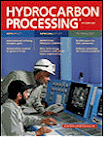Display problem ? Click HERE
Recommended :
- Tips on Succession in FREE Subscription
- Subscribes to FREE Hydrocarbon Processing
 High frequency acoustic excitation downstream of pressure reducing device potentially results downstream piping failure due to Acoustic Induced Vibration (AIV). Whenever there is pressure drop with mass passing through the valve, internal acoustic energy is generated and transmitted to downstream piping and potentially lead to severe piping excitation, vibration and stresses on downstream piping, in particular at discontinuity section i.e fabricated Tee, small bore connection, welded pipe and pipe support, etc. This acoustic excitation phenomena is generally involve high frequency (more than 1000Hz) acoustic energy. When high frequency acoustic energy is matches with mechanical natural frequency of piping and its component, excitation amplitude is at maximum and lead to increased stress level. AIV phenomenon and assessment methodology have been discussed in previous post. Sound Power Level (PWL) is commonly used in quantifying acoustic energy in AIV. Higher PWL, higher the potential of vibration level and higher the risk of AIV.
High frequency acoustic excitation downstream of pressure reducing device potentially results downstream piping failure due to Acoustic Induced Vibration (AIV). Whenever there is pressure drop with mass passing through the valve, internal acoustic energy is generated and transmitted to downstream piping and potentially lead to severe piping excitation, vibration and stresses on downstream piping, in particular at discontinuity section i.e fabricated Tee, small bore connection, welded pipe and pipe support, etc. This acoustic excitation phenomena is generally involve high frequency (more than 1000Hz) acoustic energy. When high frequency acoustic energy is matches with mechanical natural frequency of piping and its component, excitation amplitude is at maximum and lead to increased stress level. AIV phenomenon and assessment methodology have been discussed in previous post. Sound Power Level (PWL) is commonly used in quantifying acoustic energy in AIV. Higher PWL, higher the potential of vibration level and higher the risk of AIV.
Principle in Eliminating & Minimizing AIV Impact
This post will focus in some common measures and techniques to eliminate and/or minimize PWL generation and transmission. The main principles in avoiding and minimizing the impact of AIV are :
- Tips on Succession in FREE Subscription
- Subscribes to FREE Hydrocarbon Processing
Principle in Eliminating & Minimizing AIV Impact
This post will focus in some common measures and techniques to eliminate and/or minimize PWL generation and transmission. The main principles in avoiding and minimizing the impact of AIV are :
- Eliminate or reduce vibration level at pressure reduction device
- Damper vibration level
- Increase resistance to vibration
- Minimizing vibration transmission
Application Example
A control valve discharge gas from high pressure vessel to flare header results high vibration level (or sound power level, PWL) and lead to AIV problem. The consideration shall be focused on reducing the PWL by using special trim control valve (principle no. 1). Splitting flow into several control valves in parallel may reduce the PWL (principle no.1). However one shall remember this sometime is not a good idea as common mode failure may worsen the situation. Next may consider a silencer insert downstream of control valve to damper PWL (principle no.2). One may also consider to increase piping resistance to vibration i.e. increase wall thickness (principle no.3). This high resistance piping may be extended to decrease the PWL to certain acceptable limit before it is tie in to downstream piping which is less resistance (principle no. 4).
Concluding Remark
In eliminating and minimizing AIV impact, all principles as mentioned above are not exclusive and shall be applied to maximum (if possible).
In coming post "Measures & Technique In Eliminating / Minimizing PWL", the discussion will focus on
- type of AIV source
- measures in tackling each AIV problem
Related Topic
A control valve discharge gas from high pressure vessel to flare header results high vibration level (or sound power level, PWL) and lead to AIV problem. The consideration shall be focused on reducing the PWL by using special trim control valve (principle no. 1). Splitting flow into several control valves in parallel may reduce the PWL (principle no.1). However one shall remember this sometime is not a good idea as common mode failure may worsen the situation. Next may consider a silencer insert downstream of control valve to damper PWL (principle no.2). One may also consider to increase piping resistance to vibration i.e. increase wall thickness (principle no.3). This high resistance piping may be extended to decrease the PWL to certain acceptable limit before it is tie in to downstream piping which is less resistance (principle no. 4).
Concluding Remark
In eliminating and minimizing AIV impact, all principles as mentioned above are not exclusive and shall be applied to maximum (if possible).
In coming post "Measures & Technique In Eliminating / Minimizing PWL", the discussion will focus on
- type of AIV source
- measures in tackling each AIV problem
Related Topic
- Energy Input or E-method In Assessing AIV
- Assess AIV with "D/t-method" with Polynomial PWL Limit Line
- Assess AIV with "D/t-method" with Logarithm PWL Limit Line
- Extra Attention to Common Point and Similarity on AIV Failure
- Piping Excitation When Expose to Acoustic Energy
- Acoustic Induced Vibration (AIV) Fatigue
No comments:
Post a Comment